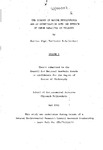The biology of marine myxosporida and an investigation into the effects of these parasites on teleosts
| dc.contributor.author | Tomlinson, Charles Nigel | |
| dc.contributor.other | School of Geography, Earth and Environmental Sciences | en_US |
| dc.date.accessioned | 2013-10-21T11:37:33Z | |
| dc.date.available | 2013-10-21T11:37:33Z | |
| dc.date.issued | 1981 | |
| dc.identifier | NOT AVAILABLE | en_US |
| dc.identifier.uri | http://hdl.handle.net/10026.1/2255 | |
| dc.description | Merged with duplicate record 10026.1/585 on 20.03.2017 by CS (TIS) | |
| dc.description.abstract |
A survey of Myxosporidia in teleosts from the South-Western. coast of England demonstrated the widespread occurrence of these parasites. Infection in selected fish species was related to age, sex and seasonal migration of the host. Structural studies of Myxobolus exiguus and Myxidium incurvatum were undertaken in order to investigate sporogenesis, parasite development and the host-parasite interface. Of particular note was the intimate association between parasite and host cells, the structure of the surface layers in Myxobolus exiguus and Myxidium incurvatum, and the occurrence of epithelioid cells in developmental stages of Myxobolus exiguus. Myxobolus exiguus was transmitted experimentally in mullet, and aspects of the mode of infection, including exsporulation, were studied in this and other species, including those with coelozoic development. patterns. Experiments designed to simulate the gut biotope identified the action of trypsin and mechanical fracture as important exsporulation factors in Myxobolus exiguus. The release of spores and their dispersal and survival outside the host were investigated, and the possible existence of intermediate transport hosts discussed. Pathological effects of histozoic and coelozoic myxosporidian infection were examined in selected hosts. Fibroblastic encapsulation of plasmodia, and hyperplasia, characterised intestinal and branchial infections of Myxobolus exiguus in mullet, and cystic replacement of renal tissue was associated with Myxidium giardi infection in eels. Biliary myxosporidiosis caused chronic irritation and fibrosis of the gall bladder wall, increased bile viscosity and discolouration. Incidence, periodicity and severity of various Myxosporidian infections are discussed with regard to their disease potential and possible impact on commercially-important teleost species. | en_US |
| dc.language.iso | en | en_US |
| dc.publisher | University of Plymouth | en_US |
| dc.title | The biology of marine myxosporida and an investigation into the effects of these parasites on teleosts | en_US |
| dc.type | Thesis | en_US |
| dc.identifier.doi | http://dx.doi.org/10.24382/1401 | |
| dc.identifier.doi | http://dx.doi.org/10.24382/1401 |
Files in this item
This item appears in the following Collection(s)
-
01 Research Theses Main Collection
Research Theses Main



